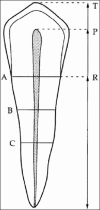Age estimation by using dental radiographs
- PMID: 24255560
- PMCID: PMC3826039
- DOI: 10.4103/0975-1475.119778
Age estimation by using dental radiographs
Abstract
Background: Estimation of age is important in forensic sciences as a way to establish the identity of human remains. Of the various parts of the body used in age estimation, teeth are the least affected by the taphonomic process. Their durability means that they are sometimes the only body part available for study. Several methods of age estimation have been studied using bone and teeth, and among them, tooth wear and apposition of secondary dentine are the currently available non-destructive methods.
Objectives: The purpose of the study was to determine the age of adults by using Kvaal's method as well as to establish the relationship of chronological age and dental age with its reliability and limitations on digital panoramic radiographs.
Materials and methods: The present study was based on panoramic radiographs that consisted of two groups. One hundred orthopantomographs with Kvaal's criteria (Group A) and 50 orthopantomographs without Kvaal's criteria (Group B) were included. Various parameters were measured and the result was analyzed by means of SPSS-12.0 program statistical data.
Result and conclusion: On the basis of Kvaal's criteria, the difference between chronological age and real age was 8.3 years. This suggests that the accuracy of this method depends on the precision of measurements and quality and number of the orthopantomographs.
Keywords: Age estimation; Kvaal's method; orthopantomographs; panoramic radiographs; pulp/tooth area ratio; secondary dentine.
Conflict of interest statement
Figures




References
-
- Willems G, Moulin-Romsee C, Solheim T. Non-destructive dental-age calculation methods in adults: intra- and inter-observer effects. Forensic Sci Int. 2002;126:221–6. - PubMed
-
- González-Colmenares G, Botella-López MC, Moreno-Rueda G, Fernández-Cardenete JR. Age estimation by a dental method: A comparison of lamendin's and prince and ubelaker's technique. J Forensic Dent Sci. 2007;52:1156–60. - PubMed
-
- Pretty IA, Sweet D. Look at forensic dentistry, Part 1: The role of teeth in the determination of human identity. Br Dent J. 2001;190:359–66. - PubMed
-
- Gorea RK, Singh A, Singla U. Age estimation from the physiological changes of teeth. J Indian Forensic Sci. 2004;26:94–6.
-
- Avon SL. Forensic odontology: The roles and responsibilities of the dentist. J Can Dent Assoc. 2004;70:453–8. - PubMed
LinkOut - more resources
Full Text Sources
Other Literature Sources
